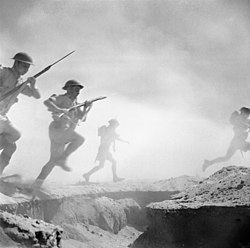
Back معركة العلمين الثانية Arabic İkinci Əl-Əlameyn döyüşü Azerbaijani ایکینجی العلمین دؤیوشو AZB Втора битка при Аламейн Bulgarian Segona batalla d'El Alamein Catalan Druhá bitva u El Alameinu Czech Andet slag om el-Alamein Danish Zweite Schlacht von El Alamein German Δεύτερη μάχη του Ελ Αλαμέιν Greek Dua Batalo de Alamejno Esperanto
| Second Battle of El Alamein | |||||||
|---|---|---|---|---|---|---|---|
| Part of the Western Desert campaign of the Second World War | |||||||
 24 October 1942: British soldiers in a posed attack | |||||||
| |||||||
| Belligerents | |||||||
|
|
Air support: | ||||||
| Commanders and leaders | |||||||
|
|
| ||||||
| Strength | |||||||
|
116,000[5][a] 547 tanks[b] 192 armoured cars[6] 770[8] – 900 aircraft[c] 552 artillery pieces[10] 496[d] – 1,063 anti-tank guns[12] |
195,000[6] 1,029 tanks[e] 435 armoured cars[6] 730[f] – 750 aircraft[g] 892[10] – 908 artillery guns[6] 1,451 anti-tank guns[6][h] | ||||||
| Casualties and losses | |||||||
|
2,000–9,000 dead or missing, 4,800–15,000 wounded, 35,000–49,000 captured[14] c. 500 tanks destroyed 254 artillery guns destroyed 84 aircraft destroyed |
13,560 killed, wounded, captured, and missing[14][i] 332–500 tanks destroyed 111 guns destroyed 97 aircraft destroyed[16] | ||||||
The Second Battle of El Alamein (23 October – 11 November 1942) was a battle of the Second World War that took place near the Egyptian railway halt of El Alamein. The First Battle of El Alamein and the Battle of Alam el Halfa had prevented the Axis from advancing further into Egypt.
In October 1942 Lieutenant-General Bernard Montgomery, commander of Eighth Army, opened his offensive against the Axis forces. In a 13-day battle the Axis Panzerarmee Afrika was crushed and forced to retreat from Egypt and Libya to the borders of Tunisia. The Allied victory at El Alamein was the beginning of the end of the Western Desert Campaign.
The battle ended the Axis threat to the Middle East and Iran and revived the morale of the western Allies, being their first big success against the Axis since Operation Crusader in late 1941. The end of the battle coincided with the Allied invasion of French North Africa in Operation Torch on 8 November, which opened a second front in North Africa.
- ^ ياغي, إسماعيل أحمد; شاكر, محمود (October 2008). "تاريخ العالم الإسلامي الحديث والمعاصر : قارة إفريقية : الجزء الثاني:–1492-1980".
- ^ "British Forces Battle of El Alamein 23 October 1942" (PDF). usacac.army.mil.
- ^ Maurer 1983, p. 120.
- ^ Latimer 2003, pp. 249–250.
- ^ Buffetaut 1995, p. 95.
- ^ a b c d e f Playfair 2004, p. 30.
- ^ Playfair 2004, pp. 9–11.
- ^ a b Barr 2005, p. 304.
- ^ a b Playfair 2004, p. 3.
- ^ a b Barr 2005, p. 26.
- ^ a b Playfair 2004, p. 10.
- ^ Barr 2005, p. 276.
- ^ Playfair 2004, p. 9.
- ^ a b Clodfelter 2017, p. 455.
- ^ Playfair 2004, pp. 404, 78.
- ^ Terraine 1985, p. 385.
Cite error: There are <ref group=lower-alpha> tags or {{efn}} templates on this page, but the references will not show without a {{reflist|group=lower-alpha}} template or {{notelist}} template (see the help page).